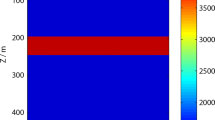Abstract
On the basis of the dislocation theory and gravity observation, a joint inversion model is presented with a fitting factor λ scaling amplitudes between the gravity and GPS observation data. The test results show that the new joint model is better than that taking the scale factor λ as a constant from the inversion result of MSE (mean square error). In addition, the random cost method used in the inversion algorithm is revised and improved, which shows that the improved random cost method can easily get the local minimum value and greatly decrease the iteration steps.
Similar content being viewed by others
References
Steketee J A (1954) Some geophysical applications of the elasticity theory of dislocations.J. Phys., 36: 1 168–1 198
Savage J C, Hastie L M (1966) Surface deformation associated with dip-faulting.J. Geophys. Res., 71: 4 897–7 904
Mashinha L, Smylie D E (1971) The displacement fields of inclined faults.Bull. Seism. Soc. Am., 61: 1 433–1 440
Sato R (1971) Crustal deformation due to dislocation in a multi-layered medium.J. Phys. Earth, 19: 29–46
Sato R, Matsu'ura M (1973) Static deformation due to the fault spreading over several layers in a multilayered medium. Part I: Displacement.J. Phys. Earth, 21: 227–249
Sato R, Matsu'ura M (1975) Static deformation due to the fault spreading over several layers in a multilayered medium. Part II: Dip-slip fault.J. Phys. Earth, 23: 113–125
Okada Y (1985) Surface deformation due to shear and tensile faults in a half-space.Bull. Seism. Soc. Am., 75: 1 135–1 154
Okada Y (1992) Internal deformation due to shear and tensile faults in a half-space.Bull. Seism. Soc. Am., 82: 1 018–1 040
Okubo S (1991) Potential and gravity changes raised by point dislocations.Geophy. J. Int., 105: 573–586
Okubo S (1992) Gravity and potential changes due to shear and tensile faults in a half-space.J. Geophys. Res., 97: 7 137–7 144
Pollitz F (1992) Postseismic relaxation theory on the spherical earth.Bull. Seism. Soc. Am., 82: 422–453
Pollitz F (1996) Coseismic deformation from earthquake faulting on a layered spherical earth.Geophys. J. Int., 125: 1–14
Pollitz F (1997) Gravitational viscoelastic postseismic relaxation on a layered spherical Earth.J. Geophys. Res. 102: 17 921–17 941
Harris R A, Segall P (1987) Detection of a locked zone at depth on the parkfield.J. Geophys. Res., 92:7 945–7 962
Murray M H, Marshall G, Lisowski M, et al. (1996) The 1992M=7 cape mendocino california, earthquake: coseismic deformationathe south end of the Cascadia magathrust.J. Geophys. Res., 101: 17 707–17 725
Cervelli P, Murray M, Segall P, et al. (2001) Estimating source parameters from deformation data, with an application to the March 1997 earthquake swarm off the Izu Peninsula.J. Geophys. Res., 106: 11 217–11 237
Larson K M, Brgmann R, Bilham R, et al. (1999) Kinematics of the India-Eurasia collision zone from GPS measurements.J. Geophys. Res., 101: 1 077–1 093
Jeff F, Murray M H, Segall P, et al. (1999) Kinematics of the Pacific-North America plate boundary zone, northern California.J. Geophys. Res., 104 (B4): 7 419–7 441
Zhao S R (1995) Joint inversion of observed gravity and GPS baseline changes for the detection of the active fault segment at the Red River fault zone.Geophys. J. Int., 122: 70–88
Berg B A (1993) Locating global minima in optimization problems by a random-cost approach.Nature, 361: 708–710
Author information
Authors and Affiliations
Additional information
Project supported by Program for New Century Excellent Talents in University (No. NCET-04-0681); Hubel Province Excellent Young Sciencisit Foundation (No. 2002AC011); the National Natural Science Foundation of China (No. 40344023) Fund of Key Laboratory of Geodesy and Dynamic, Institute of Geodesy and Geophysics, Chinese Academy of Science (No. L04-02); and Open Research Fund Program of the Key Laboratory of Geospace Environment and Geodesy, Ministry of Education. China (No. 905276031-04-08, 950276031-04-10).
About this article
Cite this article
Zhicai, L., Caijun, X. An improved method of joint inversion using GPS and gravity observation data. Geo-spat. Inf. Sci. 8, 225–229 (2005). https://doi.org/10.1007/BF02826826
Received:
Issue Date:
DOI: https://doi.org/10.1007/BF02826826




